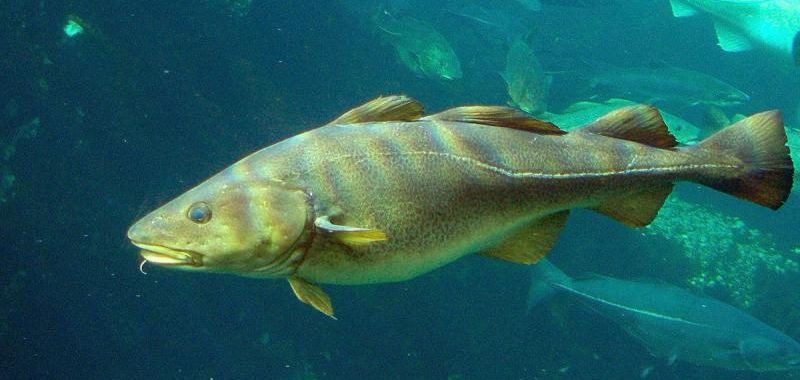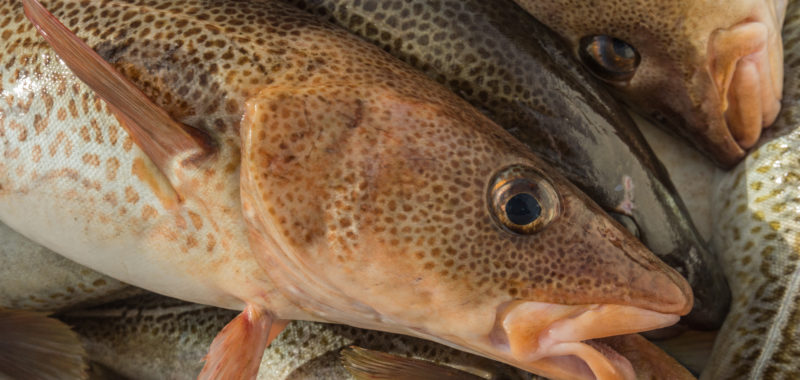Priority Species: Atlantic Cod
Scientific name: Gadus morhua
DFO Stock Status: Critical Zone (6/8 stocks), Cautious Zone (2/8 stocks)
COSEWIC Status: Endangered (Newfoundland and Labrador, Laurentian North, Laurentian South, Southern), Special Concern (Arctic Lakes)
Dive deeper into stock-specific status details.
Overall, Atlantic cod populations remain at extremely low levels, compared to their historical abundance. While some populations have exhibited signs of recovery since the groundfish moratorium in 1992, stocks continue to fluctuate and broad recovery has not occurred yet. Despite all stocks being assessed by the Canadian government as in either critical or cautious zones, targeted fisheries, a stewardship fishery and a recreational fishery still exist.
In addition to fishing mortality3 from commercial and recreational fisheries, many Atlantic cod stocks are showing high levels of natural mortality4. The resulting natural instability of the stocks can aggravate the population impacts of fishing. Additionally, cod continue to be caught as bycatch in other fisheries for which there are inadequate levels of bycatch recording and monitoring, particularly in lobster fisheries.
Atlantic cod has been under consideration for listing under the Canadian Species at Risk Act (SARA) since 2009, with no decision as of 2018.
Population: All Atlantic cod populations should have rebuilding plans in place by 2020, with realistic timelines and targets for expected recovery. Targeted fisheries for populations in the critical zone should be re-evaluated and limited. When natural mortality is a known impediment to rebuilding, potential solutions to reduce further impacts on the populations should be explored. SeaChoice and its partner organizations will continue to engage in the advisory committees for Atlantic cod, participate as stakeholders in the MSC certification process, and advocate for meaningful rebuilding plans, harvest control rules, ecosystem-based fisheries management and increased bycatch monitoring and reporting.
Bycatch: Bycatch limits should be placed on fisheries where they currently do not exist, and accurate bycatch reporting should be a priority in all fisheries where Atlantic cod is caught.
Habitat: Habitat protection provisions should be put in place through marine protected areas and fisheries closures, with the aim to limit fishing in areas large enough to allow for population recovery.
Gear: Low impact fishing gear should be used, including handlines and pots, wherever possible.
Monitoring: Prioritize improved monitoring for bycatch in fisheries where cod is thought to occur, through catch monitoring pilot projects, until Canada adopts a national Catch Monitoring Policy.
Markets: SeaChoice will continue to engage with markets where Canadian Atlantic cod is sold, and request they source from more sustainable fisheries that use science-based decisions to set quota, maintain a healthy stock status, and use low impact gear. Market efforts will also focus on assessing impacts of the U.S. Seafood Import Monitoring Program (SIMP) regulations on this fishery.
Related SeaChoice MSC submissions can be found here
Press Releases – EAC:
- Eco-certification of Endangered Cod Population Undermines Credibility of the Marine Stewardship Council; Raises Questions on DFO Rebuilding of Atlantic cod — March 23, 2016
- Conservation Group Maintains Concerns Regarding Cod Stock Rebuilding, Following Eco-Certification Suspension — May 16, 2017
Objection to MSC Certification – EAC:
DFO – Aquatic Species at Risk profiles:
Common/Market Name
Atlantic Cod/Northern Cod
Distribution
Nova Scotia, Newfoundland & Labrador, Nunavut, Gulf of St. Lawrence
Harvest Method
Gear types: bottom trawl, bottom longline, bottom gillnet, traps and pots, handline
Management Agency
Department of Fisheries and Oceans Canada (DFO): Maritimes Region, Gulf Region, Quebec Region, Newfoundland and Labrador Region
Market Distribution
Canada exported more than 55 per cent of our Atlantic cod production in 2015; most was exported to the United States (data from DFO and Statistics Canada).




